
Deutsch-Chinesische Enzyklopädie, 德汉百科

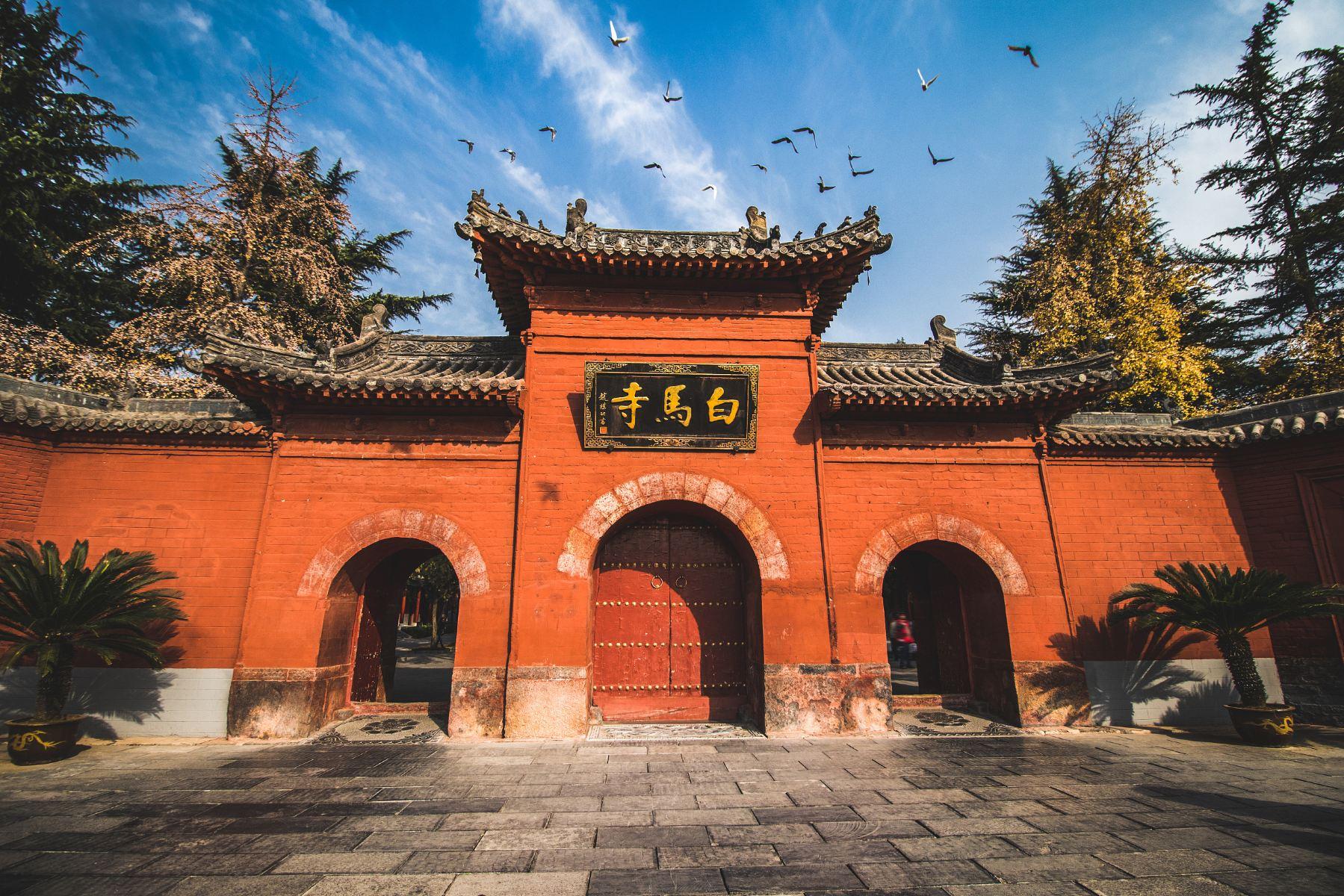

白马寺的营建与中国历史上的“永平求法”紧密相连。东汉明帝曾夜梦丈六金人,顶佩白光,自西方飞来。大臣傅毅认为这是西方的佛,汉明帝遂“感梦求法”,令蔡愔、秦景、王遵等十余人于永平七年(64年)赴天竺(古代印度)求佛法。[3]他们在西域的大月氏(古代阿富汗)遇到了来自天竺的僧人摄摩腾和竺法兰,得佛经佛像,于是相偕同行,以白马驮经,并于永平十年(67年)来到当时的京城雒阳。为了给两位高僧一个居住和翻譯《四十二章經》的地方,汉明帝敕命在城西的雍门外按天竺式样建造了一组建筑,以僧人们暂住的“鸿胪寺”的“寺”字称之,为了纪念白马驮经之功,便将这组建筑命名为“白马寺”。
Das Kloster des weißen Pferdes liegt circa 12 Kilometer östlich der heutigen Stadt Luoyang in der Provinz Henan und soll angeblich im Jahre 68 gegründet worden sein.
Sein Name geht auf die folgende Legende zurück, die im "Buch über die Späte Han Dynastie" enthalten ist, das im 5. Jahrhundert kompiliert wurde.
Der Kaiser Ming aus der Östlichen Han Dynastie träumte im Jahre 64 von einer goldenen Gestalt, die über seinem Palast schwebte. Seine Minister erklärten ihm, daß er vom Buddha in Indien geträumt habe. Der Kaiser sandte daraufhin eine 18-köpfige Delegation nach Indien, die dort den Buddhismus studieren sollte. Nach drei Jahren kehrte die Delegation aus der Gegend des heutigen Afghanistan, wo sie die beiden indischen Mönchen Kashyapamtanga und Dharmaraksha getroffen hatte, zurück. Mit ihnen kam ein weißes Pferd, das ein Bündel voller buddhistischer Sutren und Figuren trug. Im folgenden Jahr ließ dann der Kaiser den Tempel für die Mönche und zur Erinnerung an die Ankunft des weißen Pferdes bauen. (Quelle:http://www.china-entdecken.com/LandundLeute/Louyang-Baima%20Si.htm)
迦葉摩騰と竺法蘭の二人の僧が、白馬に乗り『四十二章経』という経典を携えて、都の洛陽を訪れたという説話に因んで、白馬寺と名づけられた。[1]
『洛陽伽藍記』巻4によると、北魏時代には後漢の明帝が建立した寺として、洛陽城の城西、西陽門外3里の地点にあったと記される。北魏の頃には、寺に安置された経函が放光し、その経函に対する信仰があったことが記される。ただし、その経函中に収められた経典が『四十二章経』であるとは明記されていない。
White Horse Temple (Chinese: 白马寺) is Buddhist temple in Luoyang, Henan that, according to tradition, is the first Buddhist temple in China, having been first established in 68 AD under the patronage of Emperor Ming in the Eastern Han dynasty.[1][2][3]
The site is just outside the walls of the ancient Eastern Han capital, some 12–13 kilometres (7.5–8.1 mi) east of Luoyang in Henan Province. It is approximately 40 minutes by bus No. 56 from Luoyang railway station.[4] The temple, although small in comparison to many others in China, is considered by most believers as "the cradle of Chinese Buddhism".[5] The geographical landmarks to the south are Manghan mountain and Lucoche River.[6]
The main temple buildings, a large complex, were reconstructed during the Ming (1368 to 1644) and Qing (1644 to 1912) dynasties.[7] They were refurbished in the 1950s, and again in March 1973 after the Cultural Revolution. It has numerous halls divided by courtyards and manicured gardens, covering an area of about 13 hectares (32 acres). The display plaques in Chinese and English give ample descriptions of the Buddhist deities installed in the halls. Significant statues include Śākyamuni Buddha, Maitreya (the laughing Buddha in China), the Jade Buddha, figures of saints such as Guru Avalokiteśvara, Amitābha and arhats and stone statues of the two white horses which brought the Indian monks to China and two mythical lions at the entrance.[1][2][3] Under international funding, the temple has undergone many changes, both structurally and internally. The most recent cooperative project, with India, was completed in 2008 when the Sanchi Stupa and the Sarnath Buddha statue were erected.
Le temple du Cheval blanc (chinois simplifié : 白马寺 ; chinois traditionnel : 白馬寺 ; pinyin : ) de Luoyang, province du Henan, en République populaire de Chine, est un complexe monastique bouddhique situé dans la banlieue est de la ville moderne, à l’emplacement où, selon la tradition, s’arrêta en 67 ap. J.-C. le cheval portant depuis l’Afghanistan les premiers soutras. Les constructions et objets qu’il renferme datent essentiellement de la période allant des Jin au milieu des Qing (XIIe-XVIIIe siècles) et comprennent en particulier un ensemble de statues de laque de l’époque Yuan (1271-1368). Il fait partie depuis 1961 du patrimoine culturel protégé1.
D’autres temples portèrent ou portent encore le même nom. Certains font directement référence au Baimasi de Luoyang, d’autres ont pu être nommés indépendamment2.
Il monastero del Cavallo Bianco (白馬寺T, 白马寺S, Báimǎ-sìP) è, secondo la tradizione, il primo tempio buddhista della Cina, fondato nel 68 d.C. sotto l'imperatore Ming (r. 58-75 d.C.) degli Han Orientali, situato nella capitale Luoyang.[1][2][3]
Il monastero si trova appena al di fuori delle mura dell'antica capitale degli Han Orientali, distante circa 12-13 km a est dall'attuale Luoyang, provincia dello Henan. Dista approssimativamente 40 min coll'autobus no. 56 dalla stazione ferroviaria di Luoyang.[4] Il tempio, nonostante le sue ridotte dimensioni, è considerato da molti fedeli come "la culla del buddhismo cinese".[5] I punti di riferimento geografici sono, partendo da sud, il monte Manghan e il fiume Luo.[6]
Le principali costruzioni del monastero furono erette durante le dinastie Ming (1368-1644) e Qing (1644-1912);[7] vennero ristrutturate negli anni 1950, e poi nel marzo del 1973 dopo la Rivoluzione Culturale. È costituito da numerose sale separate da cortili e giardini ben curati, coprendo un'area di 13 ettari. Le placche in cinese e in inglese danno una ricca descrizione delle statue buddhiste situate in ogni sala; esse raffigurano, tra gli altri, Śākyamuni, Maitreya, il Buddha di Giada, icone di santi come Guru Avalokiteśvara, Amitābha, arhat, due cavalli bianchi portati dall'India da due monaci indiani, e due leoni mitici all'entrata.[1][2][3] Per via dei finanziamenti internazionali, il tempio ha subito numerosi cambiamenti, sia strutturalmente che internamente. Il progetto più recente, realizzato colla cooperazione dell'India, è stato terminato nel 2008 col completamento dello stupa di Sanchi e della statua del Buddha di Sarnath.
El Templo del Caballo Blanco (en chino: 白马寺, pinyin: Báimǎsì) es el primer templo del Budismo en la República Popular de China, establecido en el año 68, bajo el patrocinio del Emperador Ming de Han de la Dinastía Han Oriental en Luoyang.
Hoy en día el sitio está ubicado a las afueras de las murallas de la antigua capital de Han del Este, algunos 12 a 13 kilómetros al este de Luoyang en la provincia de Henan. Se encuentra aproximadamente a 40 minutos en autobús desde la estación del tren de Luoyang. El templo, aunque es pequeño en comparación con muchos otros templos de China, es considerado por la mayoría de los creyentes como "la cuna del budismo chino".
Баймасы (Храм Белой Лошади, кит. трад. 白馬寺, упр. 白马寺, пиньинь: Báimǎ Sì) — первый буддийский храм Китая. Основан при покровительстве ханьского императора Мин-ди в столичном городе Лоян в 68 г. н. э.
По сообщению «Хоу Ханьшу», поводом к основанию храма стал приснившийся императору сон о прибывшем с запада исполинском божестве, от которого исходил свет.[1] Решив по совету сановников, что речь идёт о Будде, император снарядил посольство в Индию, которое вернулось в Лоян со статуей Гаутамы и «Сутрой из 42 глав».[1]
По возвращении посольства император распорядился основать буддийский храм, первым настоятелем которого стал приехавший буддийский монах Кашьяпа Матанга.[1] Своё название он получил от белой лошади, на которой в Китай прибыли буддийские святыни.[2][3] Храм многократно перестраивался. Храмовые строения раскинулись на территории 13 гектаров в 12 км к востоку от современного города Лоян.[4]
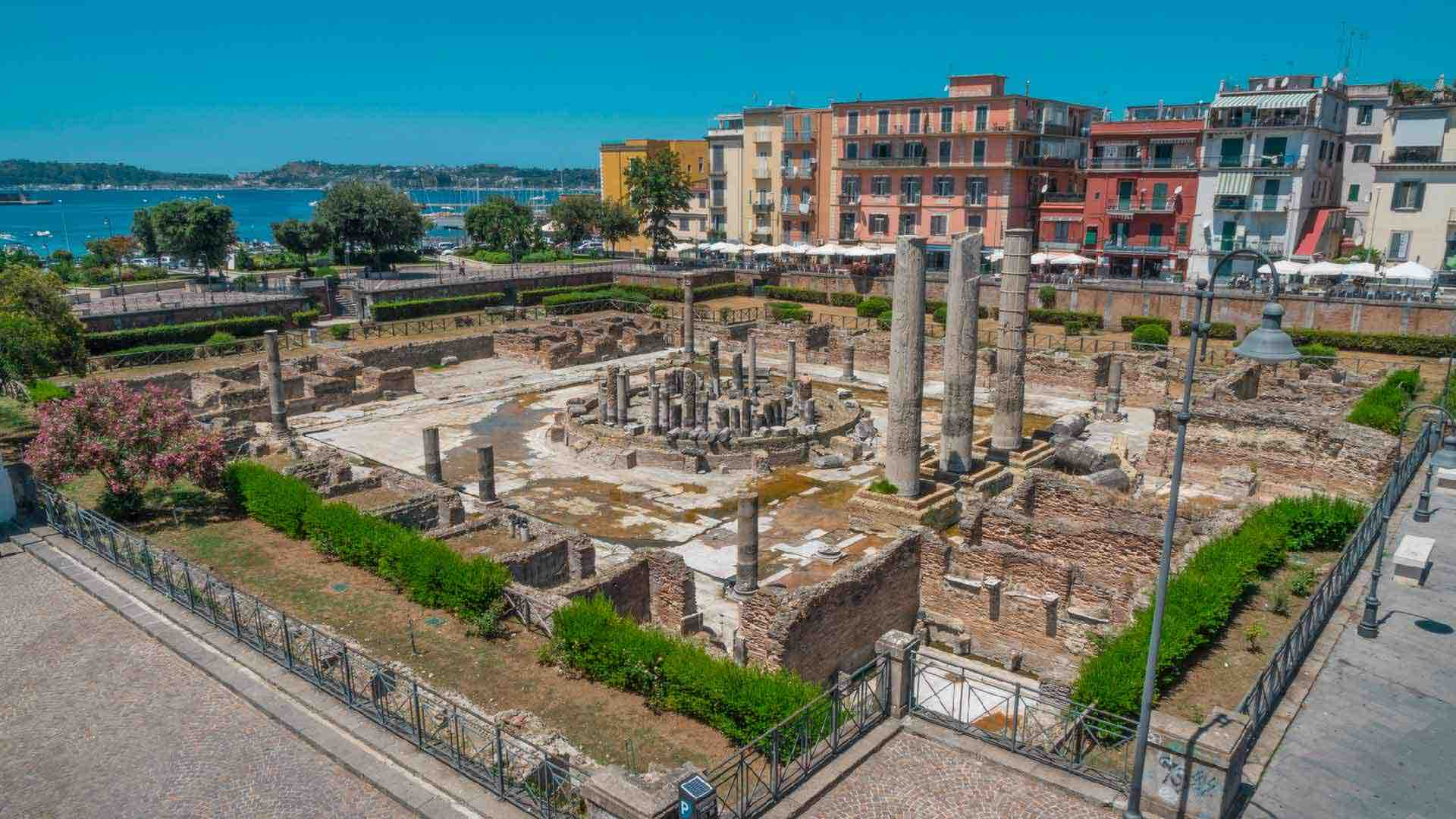

 History
History
 J 0 - 500 AD
J 0 - 500 AD

 History
History
 I 500 - 0 BC
I 500 - 0 BC

 History
History
 K 500 - 1000 AD
K 500 - 1000 AD

 History
History
 L 1000 - 1500 AD
L 1000 - 1500 AD

 History
History
 M 1500 - 2000 AD
M 1500 - 2000 AD

 History
History
 N 2000 - 2100 AD
N 2000 - 2100 AD
 Japan
Japan
 Japanese history
Japanese history
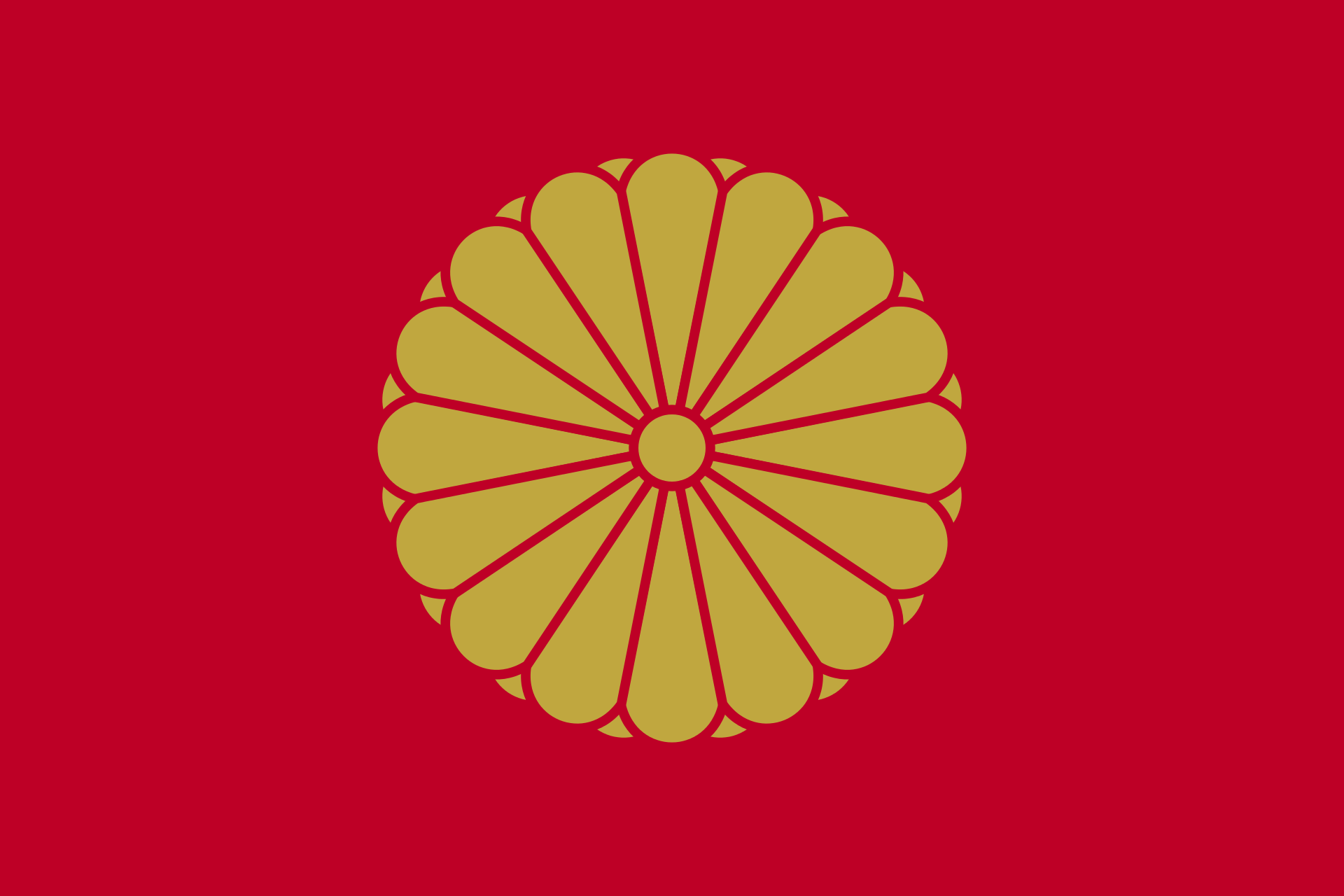
Tennō (jap. 天皇 „Himmlischer Herrscher“), eingedeutscht Tenno, ist ein japanischer Herrscher- und Adelstitel, der im Deutschen oft mit „Kaiser“ übersetzt wird, sowie in loserer Verwendung auch die Bezeichnung für das dynastische Geschlecht, das in Japan diesen Titel getragen hat. Am 30. April 2019 dankte Akihito als 125. Tennō ab, blieb jedoch bis Mitternacht formal im Amt.[1] Die Nachfolge trat dessen Sohn Naruhito als 126. Tennō an.
Ursprünglich wurde der Herrscher von Wa bzw. Yamato, wie Japan damals genannt wurde, im Land als „Großkönig“ (大王, Ōkimi) tituliert bzw. von oder nach außen (China und Korea) als „König von/der Wa“ (倭王), „König des Landes (der) Wa“ (倭国王) oder „König von Groß-Wa [= Yamato]“ (大倭王). Weitere Bezeichnungen waren suberagi, sumeragi, sumerogi, sumera-mikoto oder sumemima no mikoto. Die ersten drei sind dabei nur lautliche Varianten eines Begriffs, dessen Bedeutung unklar ist, wobei das gi wohl ein männliches Suffix (vgl. Izana-gi und Izana-mi) und mikoto ein Ehrentitel ist.
Der Kaisertitel 天皇 (chin. tiānhuáng, jap. tennō) selbst stammt aus China, wo er kurzzeitig vom Tang-Kaiser Gaozong (reg. 649–683) und seiner Nachfolgerin – der einzigen Kaiserin Chinas – Wu Zetian (reg. 684/690–705) benutzt wurde. Von letzterer vermutlich auch, weil er im Gegensatz zum traditionellen Kaisertitel Huangdi (chinesisch 皇帝) keine Geschlechtskonnotation barg. In Japan wurde der Titel erstmals von Temmu (reg. 672–686) verwendet und dann regelmäßig von seiner Nachfolgerin Jitō (686–697). Die von Temmus Sohn Toneri im Jahre 720 herausgegebene Geschichtschronik Nihonshoki wandte diesen Begriff auch auf alle Vorgänger an.[2] Dieselben Schriftzeichen wurden dann auch mit der alternativen Aussprache sumeragi versehen.
Später kam der Titel Mikado (御門, „erlauchtes Tor“) hinzu, der sich eigentlich auf den kaiserlichen Palast bezog und damit indirekt auf den Kaiser verwies, analog dem Titel Hohe Pforte im Osmanischen Reich. Daher wurde der Titel Mikado auch als 帝 geschrieben, mit dem auch die chinesischen Kaiser bezeichnet werden und das ursprünglich die Bedeutung „Gottheit“, übertragen also „Gottkaiser“, hatte. Ähnliche weitere Titel des Tennō waren Dairi (内裏, „inneres Inneres“) und Kinri (禁裏, „verbotenes Inneres“), die sich auf das Innerste des Palastes bezogen.
Zu Beginn seiner Amtszeit erlässt der Tennō eine Regierungsdevise (nengō), die sich nur aus jeweils 2 von ausgewählten 216 Schriftzeichen zusammensetzen darf. Sie dient offiziell seit 1874 zugleich als Ärabezeichnung – vor der Meiji-Restauration 1868 wurden die Nengō auch durch Shōgune und Prinzregenten verkündet, gewöhnlich nach bedeutenden Natur- oder politischen Ereignissen oder auf Basis astrologischer Erwägungen, und auch während der Amtsperiode eines Tennō geändert. Bis zu seinem Tod trägt der Tennō seinen nach seiner Geburt erhaltenen Eigennamen, wird jedoch von Japanern (außer vielleicht innerhalb seiner Familie) niemals so angeredet oder bezeichnet, sondern tennō heika (kaiserliche Majestät) angesprochen oder kinjō tennō (der gegenwärtige Tennō) genannt. Nach seinem Tod wird er nur noch mit seinem Regierungsmotto, das zugleich den „Totennamen“ bildet, und dem Suffix -tennō bezeichnet. So lautet der Name des 1989 verstorbenen Kaisers Hirohito heute „Shōwa-tennō“, abgeleitet aus der Bezeichnung seiner Amtsperiode, „Shōwa-jidai“, (dt. „Ära des erleuchteten Friedens“).
Sitz des Kaisers und der kaiserlichen Familie ist der Kōkyo im Zentrum Tokios.
天皇(日语:天皇/てんのう tennō */?)是日本的君主,为当今世界唯一使用皇帝名号的国家元首,以其为首的日本皇室则是世界上现存最古老的君主家庭。在明治维新至1947年期间施行的《大日本帝国宪法》明文规定天皇为日本的国家元首[2];之后接续施行至今的《日本国宪法》则定义其为“日本国以及日本国民整体的象征”,为“有实无名”的虚位元首。主要职责是任命首相、批准国务大臣的任免、签署法律和命令、以及进行礼仪性的外交事务等。
天皇族系号称“万世一系”,从首任的神武天皇(传说公元前660年登基)以来一脉相传,并不像中国、朝鲜、越南等周边国家经历过改朝换代,这是由于天皇在日本历史上能掌握实权的时间很短,反而能避过战乱,使皇室更加长寿。
在神道信仰的传统中,天皇被认为是天照大神的后裔,故具有“神性”,由此天皇与整个皇室在日本古代被认为是超乎普通人的存在,因此时至今日都没有姓氏(历史学研究上称其为天皇氏或天皇家)。另外,日本传统上视天皇为神道的最高祭司,所以天皇必须信奉神道信仰,[来源请求]。二战后,昭和天皇发表《人间宣言》,放弃天皇被赋予的神性。
通常,现任天皇被称为“今上天皇”,敬称“陛下”。退位后的天皇尊为“太上天皇”(简称上皇);若其退位后出家则尊为“太上法皇”(简称法皇)。第125代天皇明仁于2019年生前退位时,则首开先例不采用“太上天皇”尊号,改封新尊号为“上皇”,以避免让外界联想起日本历史上的院政。至于天皇驾崩时,将先被称为“大行天皇”,之后再正式讳称为“○○天皇”;明治时代实施一世一元制后,天皇的讳称改为直接采用在世时的元号,例如明治天皇。
天皇(てんのう、英:Emperor[要出典])は、日本国憲法に規定された日本国および日本国民統合の象徴たる地位、または当該地位にある個人[4][5][6]。7世紀頃に大王が用いた称号に始まり、歴史的な権能の変遷を経て現在に至っている[6]。在位中の天皇は、上皇明仁第1皇子である徳仁(今上天皇)。
「てんのう」は、「てんおう」の連声(れんじょう)とされる[7][8]。古代の日本では、ヤマト王権の首長を「大王」(オオキミ)といったが、天武朝ごろから中央集権国家の君主として「天皇」が用いられるようになった[8]。「天皇」は大和朝廷時代の大王が用いた称号であり、奈良時代から平安時代にかけて政治・祭祀の頂点だったが、摂関政治・院政・武家の台頭により政治的実権を失っていった[7]。室町時代には多くの宮中祭祀の廃絶もあり劣位となったが、「江戸時代末に尊王論が盛んとなり、王政復古、明治憲法における天皇制へとつながった」といわれる[7]。
大日本帝国憲法では、国家元首であって、神聖不可侵であり、かつ統治権を総攬[注釈 3]するものとして規定されていた[4][7][8]。大日本帝国時代に天皇は
といった類の呼称をされており、こうした天皇を全世界・全宇宙の頂点とする価値観は
とのように呼称されていた[10]。(詳細は天皇#一神教・国家神道を参照。)「皇帝」と「天皇」は併用されていたが、1936年(昭和11年)には「天皇」に統一された[4]。
君主とは伝統的に、国家で特定の一人が主権を持つ場合のその主権者であり[11]、王・帝王・天子・皇帝・きみなどとも言われる[12]。『日本大百科全書』は、天皇は通常の立憲君主の権限は無いとし、『法律用語辞典(第4版)』は、象徴天皇と元首天皇を別としている[13]。また『国史大辞典』は法制上、象徴天皇は君主ではないとしている[14]。
大日本帝国憲法では第4条で「天皇ハ国ノ元首ニシテ統治権ヲ総攬(そうらん)」するとの明記があったが、現行の日本国憲法には元首の規定はなく、そのため元首について様々な見解がある[15]。象徴天皇を元首とする説、実質的機能を重視し内閣(または首相)を元首とする説、元首は不在とする説等がある[16]。学説の大多数は、条約締結や外交使節任免および外交関係処理の権限をもつ内閣を元首とするか、内閣を代表する内閣総理大臣を元首としている[17]。内閣法制局は「日本国憲法においては天皇を元首であるといっても差し支えない」「天皇は限定された意味で、国家元首である」とする一方、最終的には定義によるとしている。
『世界大百科事典』によると、日本国憲法によって主権者は国民となり、「天皇は主権者の一員でもない」とされている[18]。「象徴規定にはとくに法的意味はなく、また国民を統合する機能は憲法上天皇には期待されていない」という[18]。天皇へ認可された権能は極めて限定されており、「行政権ももたず国を対外的に代表することもない天皇を君主とか元首とみることは困難」とされる[18]。天皇の地位は主権者である国民の総意に基づいており(第1条)、「国民の総意によって天皇制度を改廃することが可能」となっている[18]。「神勅主義は明確に否定されているので、神秘的・宗教的要素がここに介入する余地は皆無」であり、天皇は公的な宗教的活動が禁止されている(第20条)こともあって、「天皇、国家の世俗化が要求されている」[18]。「神道が特別な地位を与えられることはもはや許されない」のであり、皇位継承の際に行われた大嘗祭や三種の神器の継承は、「天皇家の私事としてのみありうる」とされる[18]。 天皇は憲法が限定的に列挙している国事行為だけを行い、国政に関する権能は一切持たない(第4条、第6条 - 第7条)[18]。国事行為は国家意思形成に関わらない形式的・儀礼的行為であり、天皇が国事行為を行うには常に内閣の助言と承認が必要であって、内閣は自らの助言と承認に責任を負う(第3条)[18]。天皇は国事行為の責任を負わないが、民事責任は負っている[18]。天皇の刑事責任を免責する明文規定は無いが、摂政はその在任中は訴追されないと定める皇室典範21条から、天皇もその在位中は訴追されないとの類推がある[18]。
The Emperor of Japan is the head of the Imperial Family and the head of state of Japan. Under the 1947 constitution, he is defined as "the symbol of the State and of the unity of the people." Historically, he is also the highest authority of the Shinto religion. In Japanese, the emperor is called Tennō (天皇), literally "heavenly sovereign". In English, the use of the term Mikado (帝 or 御門) for the emperor was once common, but is now considered obsolete.[1]
Currently, the Emperor of Japan is the only head of state in the world with the English title of "emperor". The Imperial House of Japan is the oldest continuing monarchical house in the world.[2] The historical origins of the emperors lie in the late Kofun period of the 3rd–7th centuries AD, but according to the traditional account of the Kojiki (finished 712) and Nihon Shoki (finished 720), Japan was founded in 660 BC by Emperor Jimmu, who was said to be a direct descendant of the sun-goddess Amaterasu.[3][4] The current emperor is Naruhito. He acceded to the Chrysanthemum Throne upon the abdication of his father, the now-Emperor Emeritus Akihito on 1 May 2019 at 00:00 local time (15:00 UTC).
The role of the Emperor of Japan has historically alternated between a largely ceremonial symbolic role and that of an actual imperial ruler. Since the establishment of the first shogunate in 1199, the emperors have rarely taken on a role as supreme battlefield commander, unlike many Western monarchs. Japanese emperors have nearly always been controlled by external political forces, to varying degrees. For example, between 1192 and 1867, the shōguns, or their shikken regents in Kamakura (1203–1333), were the de facto rulers of Japan, although they were nominally appointed by the emperor. After the Meiji Restoration in 1867, the emperor was the embodiment of all sovereign power in the realm, as enshrined in the Meiji Constitution of 1889. Since the enactment of the 1947 Constitution, the role of emperor has been to act as a ceremonial head of state without even nominal political powers.
Since the mid-nineteenth century, the Imperial Palace has been called Kyūjō (宮城), later Kōkyo (皇居), and is on the former site of Edo Castle in the heart of Tokyo (the current capital of Japan). Earlier, emperors resided in Kyoto (the ancient capital) for nearly eleven centuries. The Emperor's Birthday (currently 23 February) is a national holiday.
L'empereur du Japon (天皇, Tennō) est le chef de l'État japonais de facto. Selon la Constitution promulguée en 1947 lors de l'occupation ayant suivi la Seconde Guerre mondiale, il a en réalité un rôle uniquement symbolique et détient sa fonction du peuple japonais.
L'empereur actuel, Naruhito, est l'héritier d’une succession que la tradition présente comme ininterrompue et que la légende fait commencer en 660 av. J.C. avec l’empereur Jinmu, qui descend de la déesse du Soleil Amaterasu, elle-même fille des dieux démiurges créateurs du monde terrestre (l'archipel japonais) : Izanagi et Izanami.
Pour les partisans du culte impérial, dont l'influence fut prédominante lors de l'expansion de l'ère Shōwa, l'empereur avait un statut divin, symbolisé par les insignes impériaux. Ce statut a fait l'objet d'une remise en question lors de l'occupation du pays par les forces américaines, ces dernières obligeant en conséquence Hirohito à renoncer officiellement, en janvier 1946, à sa nature de « divinité incarnée » (akitsumikami) sans toutefois renoncer à son ascendance divine.
La liste officielle actuelle comprend 126 souverains (dont Naruhito), parmi lesquels on trouve 8 impératrices (dont 2 régnèrent sous deux noms différents).
Le pouvoir impérial a souvent été usurpé de fait par des chefs de familles puissantes, dont les mieux connus sont les shoguns. Pour échapper aux pressions et conserver leur pouvoir, certains empereurs « retirés » affectèrent de laisser le trône à des membres de leur famille, tout en exerçant leur contrôle depuis les coulisses.
Après avoir résidé plusieurs siècles au Kyōto-gosho à Kyoto, les empereurs se sont installés au milieu du XIXe siècle dans l’ancien château d'Edo (Tokyo), devenu Palais impérial : Kyūjō (宮城) ou Kōkyo (皇居). L'Agence impériale (宮内庁, kunaichō), située sur le domaine du Kōkyo, gère presque tout ce qui concerne l’empereur et sa famille : service du palais et menus, santé, sécurité, déplacements et emploi du temps officiel.
Secondo la Costituzione del Giappone, l'Imperatore (天皇 tennō?, letteralmente "sovrano celeste") è il simbolo della nazione giapponese e dell'unità del suo popolo. È a capo della famiglia imperiale del Giappone. Secondo l'attuale costituzione, l'imperatore è una figura simbolica e cerimoniale della monarchia costituzionale ed è ad oggi l'unico imperatore in carica al mondo. L'attuale sovrano è Naruhito, salito al trono del crisantemo il 1º maggio 2019 dopo l'abdicazione del padre, l'Imperatore Akihito.
Il ruolo dell'imperatore del Giappone ha sempre oscillato tra quello di un capo religioso di alto grado, con grandi poteri simbolici, e quello di autentico regnante imperiale. È esistito un autentico culto imperiale (l'Arahitogami) che vedeva l'imperatore come discendente delle divinità. Il termine tennō, sovrano celeste, che venne adottato per la prima volta nel VII secolo, era già in uso nel paese prima di tale adozione, e veniva usato per definire i Quattro Re Celesti (四天王 Shitennō?), i leggendari guardiani del mondo nella tradizione induista e buddhista.
El emperador de Japón (天皇 tennō?, lit., «soberano celestial») es el jefe de Estado y es el símbolo constitucionalmente reconocido de la nación japonesa y de la unidad de su pueblo. Es la cabeza de la familia imperial japonesa, la familia real del Japón.
El papel del emperador de Japón oscilaba hasta mediados del siglo XX entre un clérigo de alto rango con grandes poderes simbólicos y un auténtico gobernante imperial. Ha existido un culto imperial (Arahitogami) que considera al tennō como sumo sacerdote mediador entre los hombres y la divinidad, debido a sus cercanos lazos con los dioses japoneses (lazos de herencia). La violencia y las operaciones militares han sido considerados incompatibles con el papel del tennō al menos durante 14 siglos: por ello los monarcas japoneses no han actuado como comandantes militares, al contrario de lo habitual en Occidente. La principal función del emperador durante la mayor parte de los últimos mil años habitualmente ha sido la de simplemente autorizar u otorgar legitimidad a aquellos situados en el poder.
Bajo la Constitución moderna de Japón, el emperador se ha convertido en una figura ceremonial y simbólica con funciones similares a las de un jefe de Estado en una monarquía constitucional (ver Política de Japón). Sin embargo, ni la constitución japonesa ni ninguna otra norma atribuyen expresamente al emperador la titularidad de la jefatura del Estado.
El actual emperador, Su Majestad Imperial, es Naruhito, desde 2019, vitalicio.
La residencia del emperador japonés es el palacio de Kōkyo, localizado en el centro de Tokio, desde mediados del siglo XIX es la residencia oficial del emperador. Anteriormente los emperadores residían en Kioto.
Ciertos datos y fechas referentes a la institución imperial son objeto de discusión entre los historiadores japoneses. Muchos emperadores citados en la lista de emperadores de Japón murieron a una edad muy temprana y difícilmente se puede considerar que hubieran "gobernado" de verdad. Otros fueron eclipsados por sus predecesores, los cuales se habían retirado aparentemente a un monasterio pero continuaron ejerciendo su influencia, en un proceso llamado "reinado enclaustrado". De todos modos, es importante mantener la lista oficial entera, porque incluso hoy día la forma habitual de datación en la historia japonesa es por los reinados de los emperadores.
Импера́тор Япо́нии (яп. 天皇 Тэнно:[1], Тен-о[1]) — символ государства и единства нации Японии, исполняющий функции формального главы государства. В условиях конституционной монархии выполняет преимущественно представительские функции, имея намного меньше полномочий, чем, например, британский монарх. Реальной властью обладает глава кабинета министров — премьер-министр Японии. Титул императора передаётся по мужской линии.
Царствовавший с 7 января 1989 года император Акихито 30 апреля 2019 года отрёкся от престола[2]. C 1 мая 2019 года императором стал Нарухито.
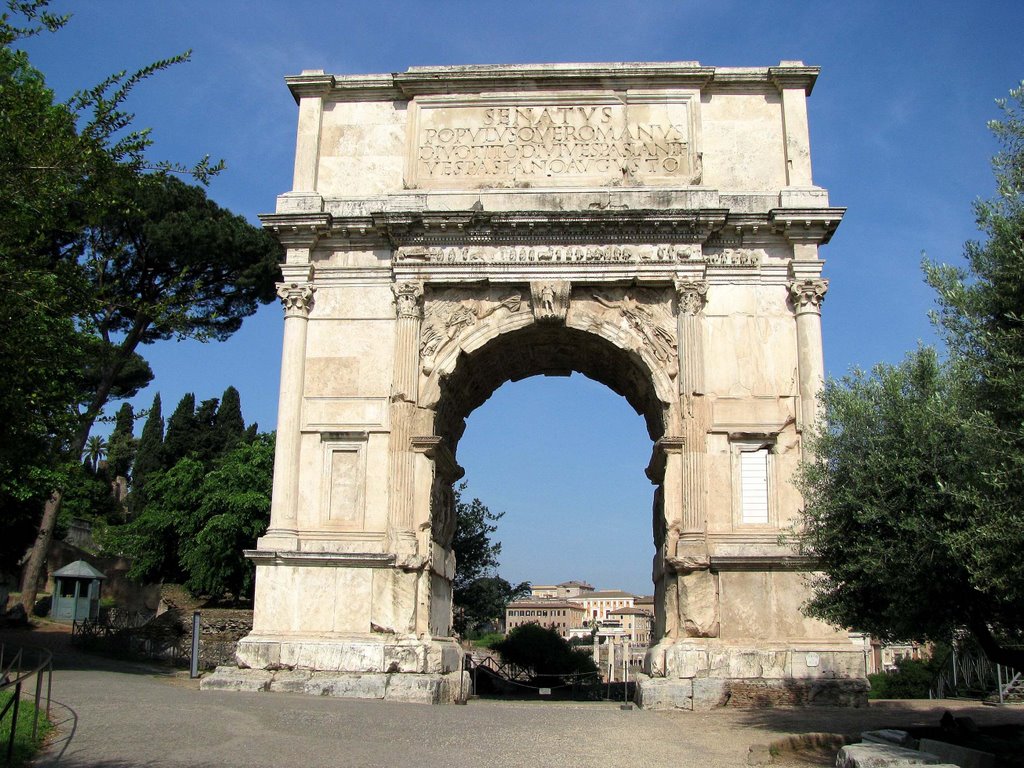
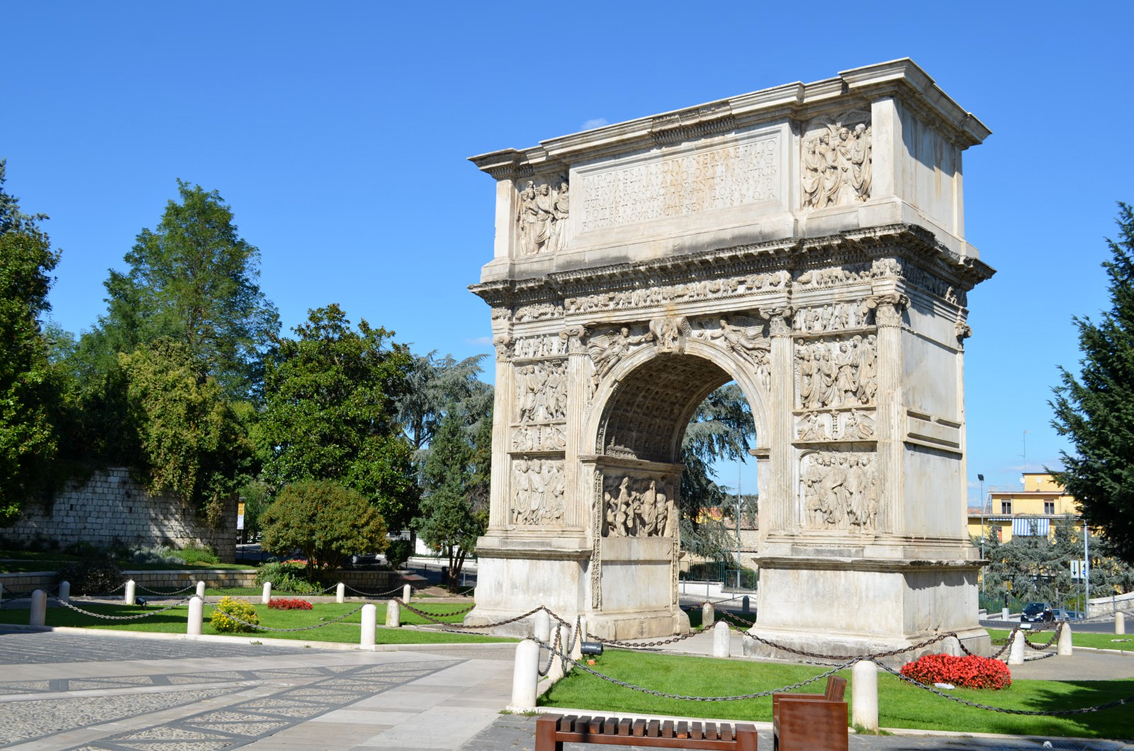


Die Hohe Domkirche St. Peter zu Trier ist die älteste Bischofskirche Deutschlands und die Mutterkirche des Bistums Trier. Mit einer Länge von 112,5 Metern und einer Breite von 41 Metern ist das Bauwerk das größte Kirchengebäude der Stadt Trier und ein bedeutendes Zeugnis abendländischer sakraler Baukunst.
Seit 1986 ist der Trierer Dom Teil des UNESCO-Welterbes Römische Baudenkmäler, Dom und Liebfrauenkirche in Trier, des Weiteren ist er ein geschütztes Kulturgut nach der Haager Konvention.
圣彼得大教堂(德语:Hohe Domkirche St. Peter)是罗马天主教特里尔教区的主教座堂,长112.5米(369英尺),宽41米(135英尺),位于德国特里尔,也是德国境内最老的主教座堂,长寿的建筑经历了十数世纪,揉合了不同世代的设计元素。1986年与特里尔其他古罗马遗址共同成为联合国教科文组织指定的世界文化遗产。

Die Vandalen (auch Wandalen, Vandali, Vandili, Vandilier und Vanduli genannt; altgriechisch Οὐανδαλοί Uandaloí, Βανδῆλοι Bandē̃loi, Βανδίλοι Bandíloi) waren ein germanisches Volk, das eine ostgermanische Sprache sprach. Zur Zeit des Tacitus siedelten die Vandalen zunächst in der nordöstlichen Germania magna, breiteten sich später aber weiter aus. Im 5. Jahrhundert gelangten vandalische Krieger im Kontext der sogenannten Völkerwanderung in das Gebiet des heutigen Spaniens und schließlich nach Nordafrika, wo sie ein eigenes regnum etablierten. Mit der Zerschlagung des Vandalenreichs im 6. Jahrhundert durch oströmische Truppen verlieren sich ihre Spuren.
汪达尔人(Vandals)是古代一个东日耳曼部族[1],在民族大迁徙中于429年占领今北非突尼斯一带,建立了汪达尔王国。公元455年,他们从海上出发,并于6月2日洗劫了罗马城。
公元533年,东罗马帝国名将贝利萨留讨伐汪达尔人,大获全胜并毁灭了汪达尔王国,将其重新纳入帝国疆土。汪达尔王国的亡国之君盖利默则被押解到君士坦丁堡,退隐度过余生[2]。汪达尔人曾在554年发动过一次武装叛乱,亦被帝国派兵迅速镇压。此后大部分汪达尔人被陆续押解到帝国各境为奴,而少部分人则分散在帝国军中服役。如此这般,汪达尔人不仅丧失了自己的国家,而且作为一个民族自此之后也消失得无影无踪。
chinesischer Heerführer, Maler und Dichter, * um 307, † um 365; erster berühmter Kalligraph Chinas, Schöpfer einer kursiven „Grasschrift“, die die geraden Balken der alten Schriftzeichen in einen kurvigen Stil verwandelte.
(Quelle:http://www.wissen.de/wde/generator/wissen/ressorts/bildung/index,page=1270408.html)

公元507年,西哥特人被克洛维一世领导下的法兰克人击败,丧失了阿基坦地区的控制权,退出了高卢 。
6世纪的伊比利亚半岛在西哥特人的统治下没有发生地震式的政治事件。伊比利亚半岛上的国王们在保留罗马的旧有行政方式上比墨洛温王朝统治者们更成功些,特别是在估税和收税方面。他们在统治早期比墨洛温王朝缺乏一个宗教方面的重要优势,因为信奉亚流派的统治者与信奉天主教的西班牙-罗马人以及犹太教臣民在信仰上并不统一。
公元587年,西哥特国王里卡雷多(586年-601年在位)带领西哥特贵族和大多数亚流派的神职人员改信天主教,总算解决了这个问题,也促进了旧罗马贵族和西哥特贵族的联合。589年,里卡雷多在都城托莱多召开教会大会,两教合为一体。随后,西哥特国王强行推进天主教的普及,与犹太教爆发了冲突。
6世纪70~80年代,西哥特王国从东罗马帝国手中收回地中海沿岸地区,而权利和财富渐渐流入强势的地方贵族手中。公元711年,倭马亚王朝入侵伊比利亚半岛,公元714年被阿拉伯帝国攻灭,西哥特王国灭亡。
Das Westgotenreich war das von 418 bis 711 (bzw. 725) bestehende Reich der Westgoten, das seinen Schwerpunkt zunächst im Südwesten Galliens, später auf der Iberischen Halbinsel hatte.
Für den Zeitraum von 418 bis 507 spricht man vom Tolosanischen Reich oder Reich von Toulouse, mit der Hauptstadt Tolosa (das heutige Toulouse). Nach dem Verlust des größten Teils der Gebiete in Südgallien einschließlich der Hauptstadt Tolosa infolge einer Niederlage gegen die Franken (507) verlagerte sich der Schwerpunkt des Westgotenreichs auf die Iberische Halbinsel. Damit begann die zweite Phase, die nach der neuen Hauptstadt Toledo Toledanisches Reich genannt wird.
Nach einer verheerenden Niederlage gegen ein muslimisches Invasionsheer unter dem Feldherrn Tariq ibn Ziyad im Jahre 711 war der Untergang des Westgotenreichs besiegelt. Einzelne Regionen leisteten länger Widerstand (in der nordöstlichen Tarraconensis bis 719, im südgallischen Reichsteil Septimanien bis 725).
Das Westgotenreich nahm seinen Ausgang von einem föderierten Kriegerverband und bildet in vielerlei Hinsicht eine Brücke zwischen Antike und Mittelalter, da hier einerseits länger als in vielen anderen Regionen des römischen Westens spätantike Strukturen fortbestanden, andererseits Lebens- und Rechtsformen des Mittelalters in einigen Bereichen prototypisch und in Ansätzen entwickelt worden sind.
西ゴート王国(にしゴートおうこく、ラテン語: Regnum Visigothorum、415年 - 711年)は、現在のフランス南部からイベリア半島にあたる地域を支配したゲルマン系王国。はじめはキリスト教アリウス派、のちにカトリックを国教とし、ゲルマン文化・ローマ文化・キリスト教文化を融合させ栄えた。ビシゴート王国とも[1]。
The Visigothic Kingdom or Kingdom of the Visigoths (Latin: Regnum Gothorum) was a kingdom that occupied what is now southwestern France and the Iberian Peninsula from the 5th to the 8th centuries. One of the Germanic successor states to the Western Roman Empire, it was originally created by the settlement of the Visigoths under King Wallia in the province of Gallia Aquitania in southwest Gaul by the Roman government and then extended by conquest over all of Hispania. The Kingdom maintained independence from the Eastern Roman or Byzantine Empire, the attempts of which to re-establish Roman authority in Hispania were only partially successful and short-lived. The Visigoths were romanized central Europeans who had moved west from the Danube Valley.[5] The Visigoths became Foederati of Rome, and wanted to restore the Roman order against the hordes of Vandals, Alans and Suebi. The Western Roman Empire fell in 476 AD; therefore, the Visigoths believed they had the right to take the territories that Rome had promised in Hispania in exchange for restoring the Roman order.[6]
Under King Euric—who eliminated the status of Foederati—a triumphal advance of the Visigoths began. Alarmed at Visigoth expansion from Aquitania after victory over the British army[7] at Déols in 469, Western Emperor Anthemius sent a fresh army across the Alps against Euric, who was besieging Arles. The Roman army was crushed in battle nearby and Euric then captured Arles and secured much of southern Gaul.
Sometimes referred to as the regnum Tolosanum or Kingdom of Toulouse after its capital Toulouse in modern historiography, the kingdom lost much of its territory in Gaul to the Franks in the early 6th century, save the narrow coastal strip of Septimania. The kingdom of the 6th and 7th centuries is sometimes called the regnum Toletanum after the new capital of Toledo. A civil war starting in 549 resulted in an invitation from the Visigoth Athanagild, who had usurped the kingship, to the Byzantine emperor Justinian I to send soldiers to his assistance. Athanagild won his war, but the Byzantines took over southern Hispania and could not be dislodged. Starting in the 570s Athanagild's brother Liuvigild compensated for this loss by conquering the Kingdom of the Suebi and annexing it, and by repeated campaigns against the Basques.
The ethnic distinction between the indigenous Hispano-Roman population and the Visigoths had largely disappeared by this time (the Gothic language lost its last and probably already declining function as a church language when the Visigoths converted to Catholicism in 589).[8] This newfound unity found expression in increasingly severe persecution of outsiders, especially the Jews. The Visigothic Code (completed in 654) abolished the old tradition of having different laws for Romans and for Visigoths.
The 7th century saw many civil wars between factions of the aristocracy. Despite good records left by contemporary bishops, such as Isidore and Leander of Seville, it becomes increasingly difficult to distinguish Goths from Latins, as the two became inextricably intertwined. Despite these civil wars, by 625 AD the Visigoths had succeeded in expelling the Byzantines from Hispania and had established a foothold at the port of Ceuta in Africa. Most of the Visigothic Kingdom was conquered by Umayyad troops from North Africa in 711 AD, with only the northern reaches of Hispania remaining in Christian hands. These gave birth to the medieval Kingdom of Asturias when a local landlord called Pelayo, most likely of Gothic origin, was elected Princeps by the Astures.
The Visigoths and their early kings were Arians and came into conflict with the Catholic Church, but after they converted to Nicene Christianity, the Church exerted an enormous influence on secular affairs through the Councils of Toledo. The Visigoths also developed the highly influential law code known in Western Europe as the Visigothic Code (Liber Iudiciorum), which would become the basis for Spanish law throughout the Middle Ages.
Le royaume wisigoth est un royaume barbare ayant existé de 418 à 711, à la suite des grandes invasions et jusqu'au haut Moyen Âge.
Il a d'abord Toulouse comme capitale (il englobe la partie de la France actuelle située entre la Loire et les Pyrénées). Après la victoire des Francs menés par Clovis Ier sur les Wisigoths d'Alaric II à la bataille de Vouillé en 507, ces derniers conservent uniquement la Septimanie (correspondant au Languedoc) et une partie de la Provence avec l'aide des Ostrogoths installés en Italie. Après la perte de Toulouse en 508, les Wisigoths installent leur capitale à Tolède ; en 575 ils conquièrent le royaume des Suèves situé dans le nord du Portugal et la Galice.
En 711 le Royaume est conquis par les musulmans.
Il regno visigoto fu un regno dell'Europa occidentale tra il V e l'VIII secolo, uno degli stati successori dell'Impero romano, originariamente creato dall'insediamento dei Visigoti in Aquitania (Gallia meridionale). I Visigoti si stabilirono qui su decisione del governo romano, per poi espandersi conquistando la penisola iberica. Il regno rimase indipendente dall'Impero bizantino, il cui tentativo di ristabilire l'autorità romana in Iberia (Spagna) fallì. All'inizio del VI secolo, i Franchi conquistarono tutta la porzione gallica del regno tranne la Settimania. L'intero regno collassò durante l'invasione musulmana proveniente dal Marocco, e alla fine il Regno delle Asturie assunse l'eredità del regno visigoto.
Il regno era condotto da un monarca eletto, obbligatoriamente di stirpe gota, tramite i consigli datogli dal Senato formato da vescovi e magnati laici. Nonostante numerosi re abbiano tentato di stabilire delle linee ereditarie, nessuno ci riuscì. I primi re furono ariani e si scontrarono con la Chiesa Romana, ma dopo la conversione dei Visigoti avvenuta al Concilio di Toledo la Chiesa esercitò un'enorme influenza sulle questioni secolari. I Visigoti svilupparono la più ampia legislazione secolare dell'Europa occidentale, la Liber Iudiciorum, che fornì le basi del diritto spagnolo medievale.
El Reino visigodo fue una entidad política establecida por el pueblo visigodo tras su asentamiento en una parte de la actual Francia y la península ibérica, en la época de las invasiones germánicas, que perduró durante buena parte de la Alta Edad Media, ocupando territorios en las Galias, Gallaecia e Hispania, en sus diversas etapas.
El Reino visigodo de Tolosa o galovisigodo, con capital en la ciudad gala de Tolosa, comenzó en el año 418, tras el pacto o foedus entre los visigodos y Roma, y duró hasta el 507, año en el que el rey Alarico II es derrotado por los francos en la batalla de Vouillé y se inicia el intermedio ostrogodo, en el que se produce una regencia ostrogoda y la actuación de los visigodos se ve supeditada a las circunstancias históricas de este pueblo, que da paso al Reino visigodo de Toledo o hispanovisigodo, con capital en la hispana Toledo, que se extendió desde el 507 hasta el 711, año en el que comienza la invasión musulmana de la península ibérica.
Короле́вство вестго́тов — раннефеодальное государственное образование, исторически первое из так называемых варварских королевств, сложившихся на территории Западной Римской империи в условиях её распада в V веке. Возникло в 418 году на территории римской провинции Аквитания по договору короля вестготов Валии с римским императором Гонорием. Первым королём вестготского государства иногда называют Теодориха I[1]. Просуществовало до 718 года, когда было почти полностью завоёвано арабами.
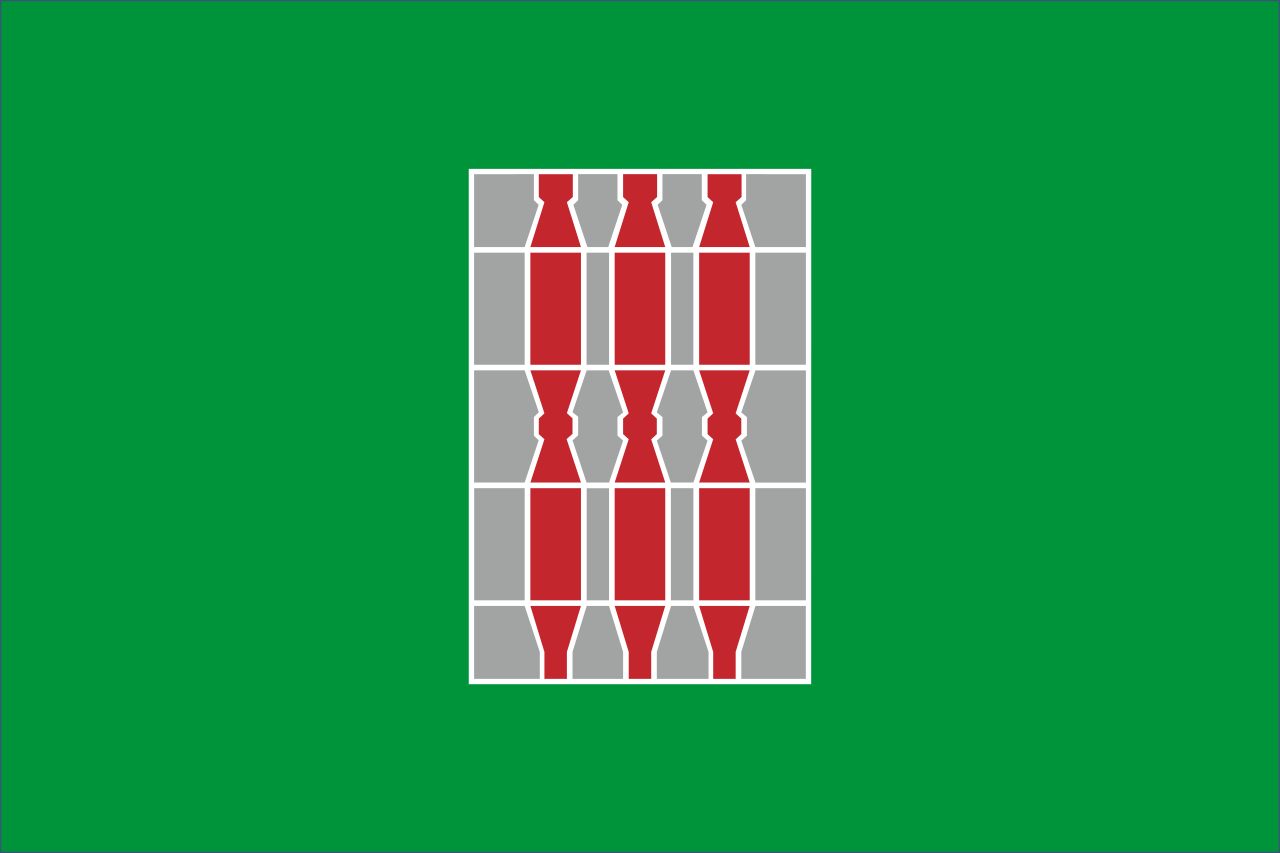 Umbria
Umbria
 Religion
Religion
 Architecture
Architecture
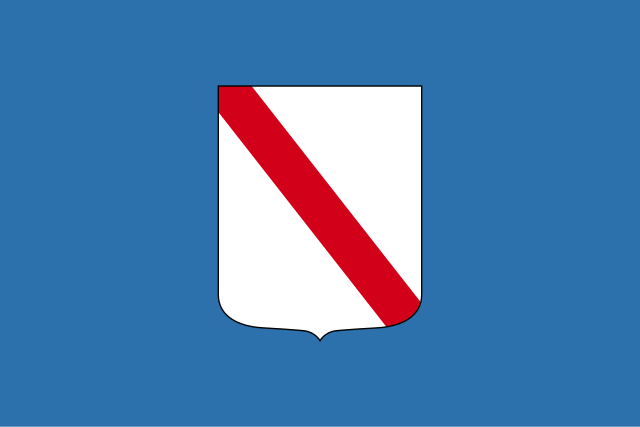 Campania
Campania
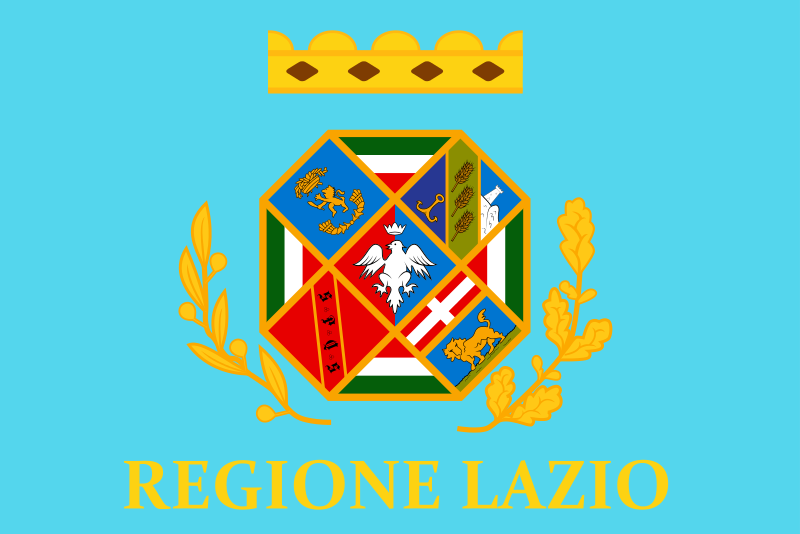 Lazio
Lazio

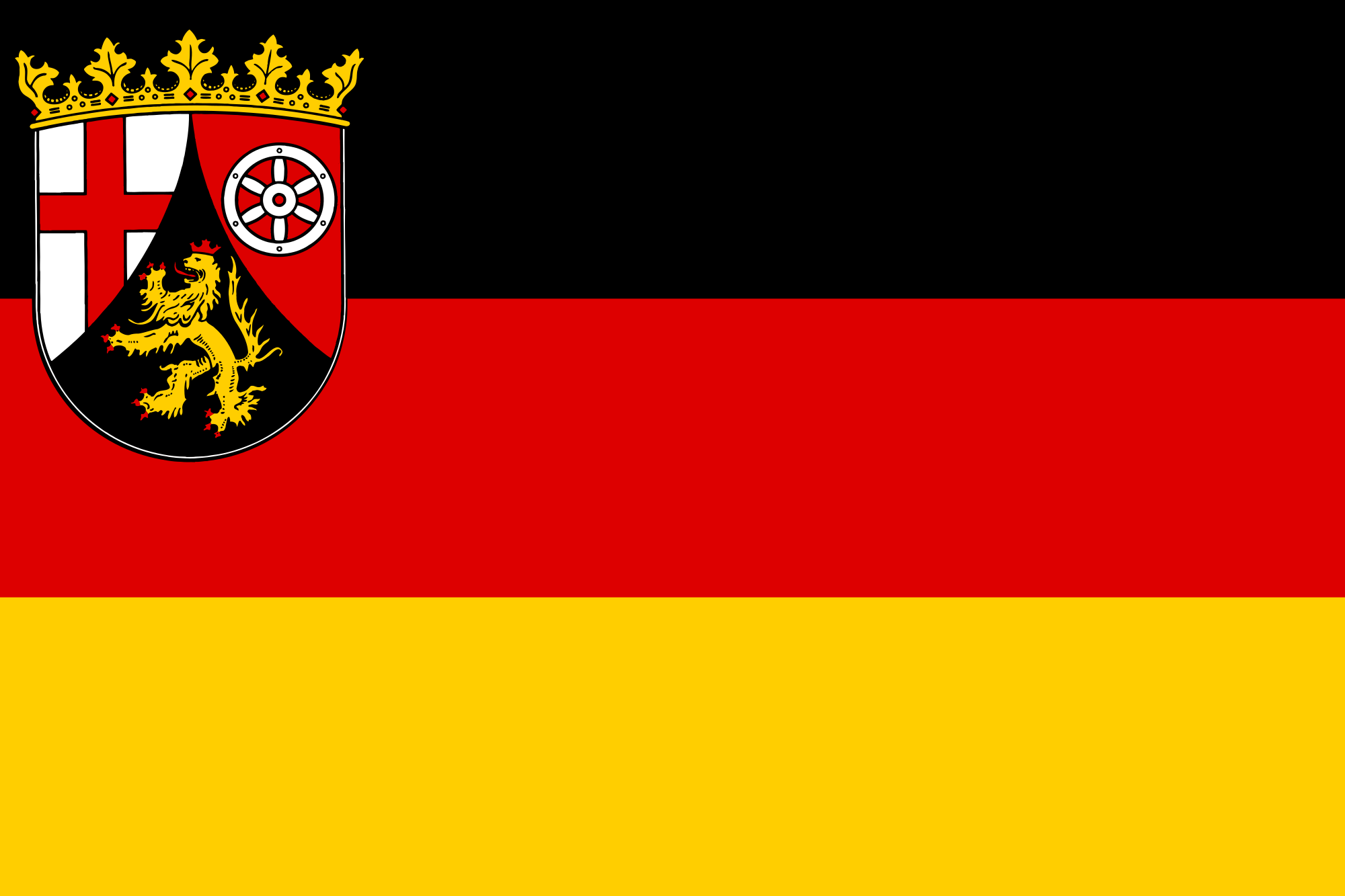 Rhineland-Palatinate
Rhineland-Palatinate
 Vacation and Travel
Vacation and Travel
 World Heritage
World Heritage

 Art
Art




